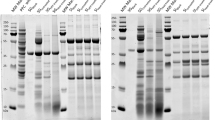Abstract
The digestibility of proteins and individual amino acids of nineteen selected foods was determined by anin vitro assay. Samples were hydrolysed with pepsin for 30 minutes in an acidic medium; the pH was then raised to 7.5 and the mixture poured into the dialysis bag (molecular weight cut-off 1000) of a digestion cell with pancreatin. Digestion products, mixtures of free amino acids and low molecular weight peptides which pass through the dialysis membrane, were collected for 6 hours by sodium phosphate buffer circulation. All proteins from animal sources displayed a digestibility similar to casein, except for breakfast sausage. Vegetable proteins showed intermediate digestibility, except for cereals (lower) or peanut butter (higher). Target amino acids of enzymes were generally more readily hydrolysed. However, compared to other animal proteins, glycine in milk products, valine, isoleucine, methionine and lysine in breakfast sausage and hot dog, and histidine in tuna were more easily released. Overheating of non-fat dried milk not only reduced the lysine digestibility, but also that of methionine, phenylalanine, histidine and cystine. Among vegetable proteins, wheat products were characterized by a relatively greater release of threonine, isoleucine and histidine, and peas by a lower digestibility of methionine and lysine. Proline of soy isolate and isoleucine of pinto bean were resistant to hydrolysis while arginine of pinto beans and of rice-wheat-gluten was easily released.
Similar content being viewed by others
References
Silano V (1976) Factors affecting digestibility and availability of proteins in cereals. In: Nutritional Evaluation of Cereal Mutants. International Atomic Energy Agency (IAEA) Vienna, pp. 13–46
Serraino MR, Thompson LU, Savoie L, Parent G (1985) Effect of Phytic acid on thein vitro rate of digestibility of rapeseed protein and amino-acids. Journal of Food Science 50(6): 1689–1692
Bodwell CE (1977) Problems associated with the development and application of rapid methods of assessing protein quality. Nutr Rep Int 16: 163–178
Friedman M, Masters PM (1980) Amino acid racemization in alkali-treated food proteins. Chemistry, toxicology, and nutritional consequences. In: Whitaker JR, Fujimaki M (eds) Chemical Deterioration of Proteins. ACS Symposium Series, No. 123. Washington, DC: American Chemical Society, pp. 165–194
Mauron J, Mottu F, Bujard E, Egli RH (1955) The availability of lysine, methionine and tryptophan in condensed milk and milk powder.In vitro digestion studies. Arch Biochem Biophys 59: 433–451
Steinhart H, Kirchgessner R (1973)In vitro Verdauungsapparatur zur enzymatischen Hydrolyse von Protein. Arch Tierernaehr 23: 449–459
Gauthier SF, Vachon C, Jones JD, Savoie L (1982) Assessment of protein digestibility byin vitro enzymatic hydrolysis with simultaneous dialysis. J Nutr 1121: 718–1725
Savoie L, Parent G (1987). Characterization ofin vitro protein digestion products by Copper-Sephadex chromatography. Nutr Rep Int 35(4): 783–790
Vachon C, Gauthier S, Jones SD, Savoie L (1983)In vitro enzymatic release of amino acid from alkali-treated proteins containing lysinoalanine. Nutr Rep Intern 27(6): 1303–1313
Savoie L, Gauthier SF (1986) Dialysis cell for the measurement of protein digestibility. J Food Sci 51: 494–498
Gauthier SF, Vachon C, Savoie L (1986) Enzymatic conditions of anin vitro method to study protein digestion. J Food Sci 51: 960–964
Vachon C, Gauthier SF, Charbonneau R, Savoie L (1987) Relationship betweenin vitro digestion products and protein quality. Reprod Nutr Develop 27: 659–672
Sarwar G, Peace RW, Botting HG, Brulé D (1989) Digestibility of protein and amino acids in selected foods as determined by a rat balance method. Plant Foods Hum Nutr 39: 23–32
Method no. 330 from Department of Food Science and Technology, Labconco Corporation, Kansas City, MO, USA
Anson ML (1938) The estimation of pepsin, trypsin, papain and cathepsin with hemoglobin. J Gen Physiol 22: 79–89
Hummel BCW (1959) A modified spectrophotometric determination of chymotrypsin, trypsin and thrombin. Can J Biochem Physiol 37: 1393
Schwert GW, Takenata Y (1955) A spectrophotometric determination of trypsin and chymotrypsin. Biochem Biophys Acta 16: 570
Spindler M, Stadler R, Tanner H (1984) Amino acid analysis of feedstuffs: Determination of methionine and cystine after oxidation with performic acid and hydrolysis. J Agric Food Chem 32: 1366
MacDonald JL, Krueger MW, Keller JH (1985) Determination of cysteine plus cystine as cysteic acid and methionine sulfone following performic oxidation. J Assoc Official Anal Chemists 68: 826–829
Hopkins DT (1981) Effects of variation in protein digestibility. In: Bodwell CE, Adkins JS, Hopkins DT (eds) Protein Quality in Humans: Assessment andin vitro Estimation. Westport, Connecticut: AVI Publishing Company
Anderson PA (1985) Interactions between proteins and constituants that affect protein quality. In: Finley WF, Hopkins DT (eds) Digestibility and amino Acid Availability in Cereals and Oilseed. St. Paul, Minnesota: American Association of Cereal Chemists, Inc., pp. 31–38
Gray MG, Cooper LH (1971) Protein digestion and absorption. Gastroenterology 61(4): 535–544
Tanksley TD Jr, Knabe A (1985) Direct measurements of amino acid digestibility in swine. In: Finley WF, Hopkins DT (eds) Digestibility and Amino Acid Availability in Cereals and Oilseeds. St. Paul, Minnesota: American Association of Cereal Chemists, Inc., pp. 259–265
Chung YC, Kim YS, Shadchehr A, Garrido A, MacGregor IL, Sleisenger MH (1979) Protein digestion and absorption in human small intestine. Gastroenterology 76: 1415–1421
Adibi SA, Mercer DW (1973) Protein digestion in human intestine as reflected in luminal, mucosal and plasma amino acid concentrations after meals. J Clin Invest 52: 1586–1594
Abidi SA, Kim YS (1981) Peptide absorption and hydrolysis. In: Johnson LR (ed.) Physiology of the Gastrointestinal Tract. New York: Raven Press, pp. 1073–1095
Author information
Authors and Affiliations
Rights and permissions
About this article
Cite this article
Savoie, L., Charbonneau, R. & Parent, G. In vitro amino acid digestibility of food proteins as measured by the digestion cell technique. Plant Food Hum Nutr 39, 93–107 (1989). https://doi.org/10.1007/BF01092406
Issue Date:
DOI: https://doi.org/10.1007/BF01092406




